Many people believe SEO is a complex topic. That is not the case. It is actually quite simple. So long as you adhere to the “five pillars” of SEO.
In this article, we will discuss the five pillars. And how we have used them to increase our monthly traffic by 495% in the past 19 months.

There is a lot of information on the web about what the five pillars of SEO are. We are here today to give our take. This insight comes from over 30 years of SEO experience in the SEOTesting team.
This advice will be different to other articles on this topic. But getting these things right will allow you to improve your organic traffic. As well as the revenue coming to your business from your website.
You can use the table of contents below to jump to the relevant pillar, if needed.
Table of contents
- Laying the foundation – Technical SEO
- Pillar 1 – Customer (& keyword) research
- Pillar 2 – Content creation and distribution
- Pillar 3 – Link acquisition
- Pillar 4 – User engagement and experience
- Pillar 5 – Brand awareness
- Roof – Testing and reporting
Laying the Foundation – Technical SEO
I did not include “technical” as one of the five pillars of SEO. It is more important than that.
Technical SEO acts as the foundation of your website. Your site cannot perform well in search results without a strong technical base.
This matters even more for large websites. Sites with thousands or millions of pages need a solid technical structure.
The bigger your site, the more you must focus on technical SEO. It is critical for success.
Sitemaps
Upload your XML sitemap to Google Search Console and Bing Webmaster Tools. This helps your pages get crawled, indexed, and ranked faster.
Search engines crawl sitemaps to find new pages. This applies to all sites, regardless of size. Use webmaster tools to keep your sitemap updated.
In Google Search Console, manage sitemaps in the “Sitemaps” section under indexing reports:
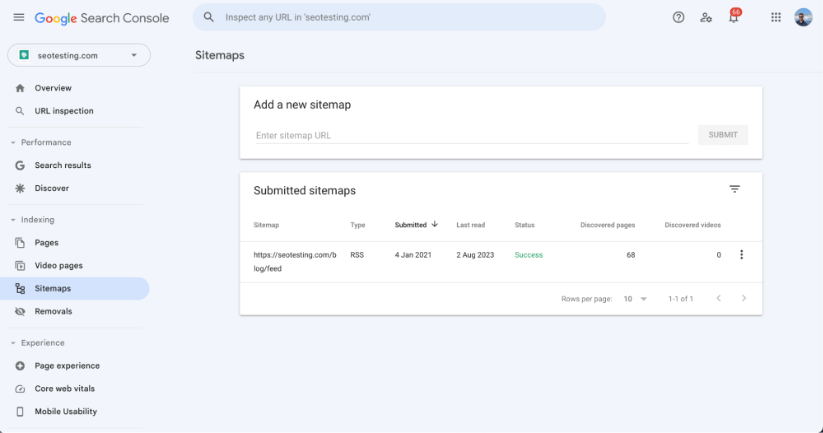
You can upload many sitemaps in Google Search Console. This is unnecessary for small websites but helps larger sites.
For large websites, crawl budget management becomes critical. Google allocates resources to crawl your site. Use many sitemaps for millions of pages to ensure important sections get attention.
You can choose to create your sitemap yourself, or use an online sitemap generator. If you are using a popular CMS such as WordPress, there will be options within those tools for them to create a sitemap for you. Once you have created your sitemap, it is important to use a sitemap validator to ensure bots will be able to crawl it.
Site Structure
A strong website structure is key for success. This applies to both small and large sites.
Good structure helps Google focus on your pages. It also improves navigation for users, which affects bounce rate and conversions. Better metrics lead to higher profitability.
Start by listing your most important pages. Examples include:
- Homepage
- Category pages
- Lead magnets
- Service pages
Place links to these in the header. This signals their importance to Google.
At the bottom of your website, list pages of lesser importance. Examples include:
- Terms and conditions pages
- Privacy policies
Structure internal links . Use a “hub and spoke” system. This connects a main topic page to related subtopic pages. These pages link back to the hub and to each other. This structure improves navigation and preserves link equity.
For example, create a central hub for a topic like Google Search Console. Link it to subpages like keyword research guides or indexing error explanations. Link the subpages back to the hub and to each other where relevant.
Your homepage should link to key sections like category pages. This gives most link equity to those pages, boosting their ranking potential.
This approach works. For example, Land of Rugs uses a strong structure to rank their product pages.

Their results show high organic rankings and increased traffic to key pages.
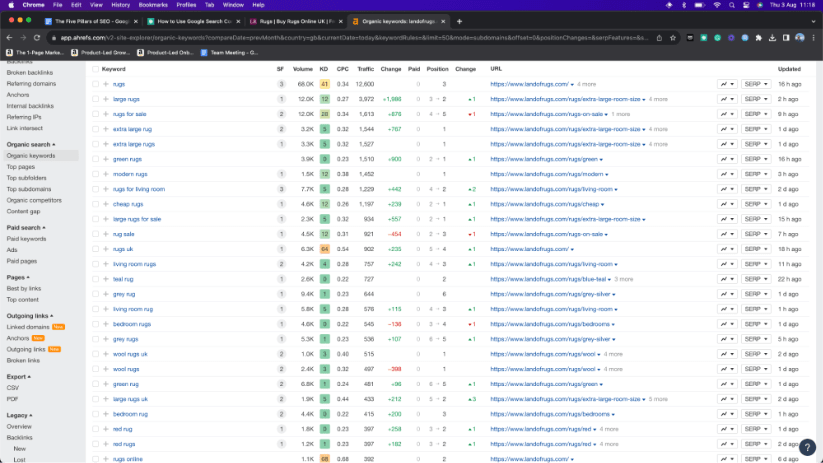
Website Speed
A fast website is essential. A 2023 Blogging Wizard article shows its impact on sales. A site loading in one second gains 30.5 sales per 1,000 visitors. At two seconds, this drops to 16.8 sales. At three seconds, it drops to 10.8 sales.
Site speed matters for all websites, not just ecommerce. Faster sites improve user experience and conversions.
Use Google Lighthouse to improve site speed. This tool crawls your site like a search engine bot and identifies slow elements.
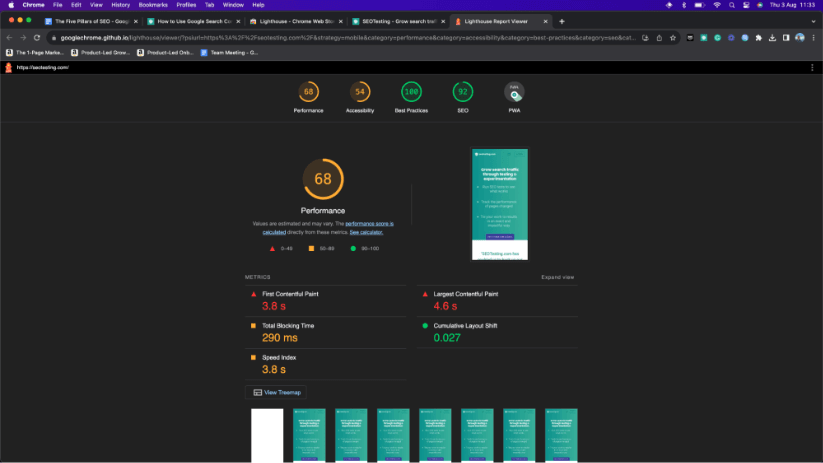
I ran a Lighthouse report for the SEOTesting website. The site scored 68, showing room for improvement. Key areas include First Contentful Paint and Largest Contentful Paint.
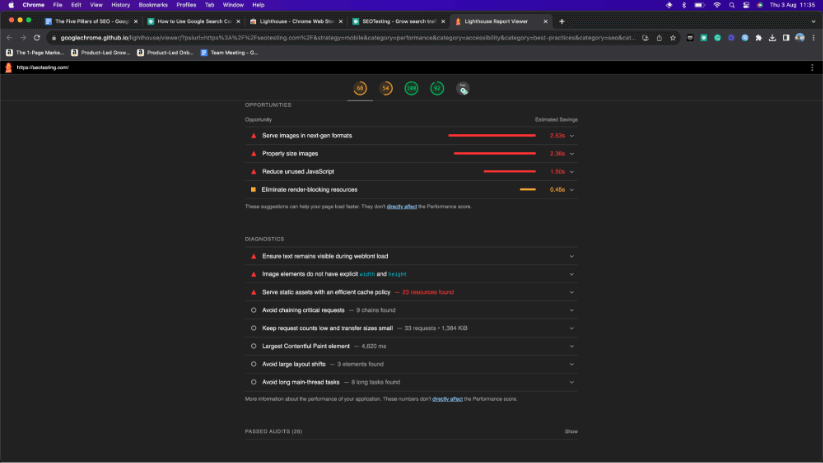
The report highlights specific actions to reduce load times. For example, serving images in next-gen formats could save 2.53 seconds. This is a simple but time-intensive fix.
The report helps communicate changes to developers. Faster websites now have an edge since Core Web Vitals scores are a confirmed ranking factor. Improving these scores may only have a small impact. But it increases your chances of ranking higher.
Mobile-Friendliness
Your website must be mobile-responsive in 2023. By August 2023, 56.66% of web traffic came from mobile devices. In 2015, this was only 31.16%.
Use Google Search Console to check if your site is mobile-friendly. The tool analyzes your pages and flags any mobile usability issues.
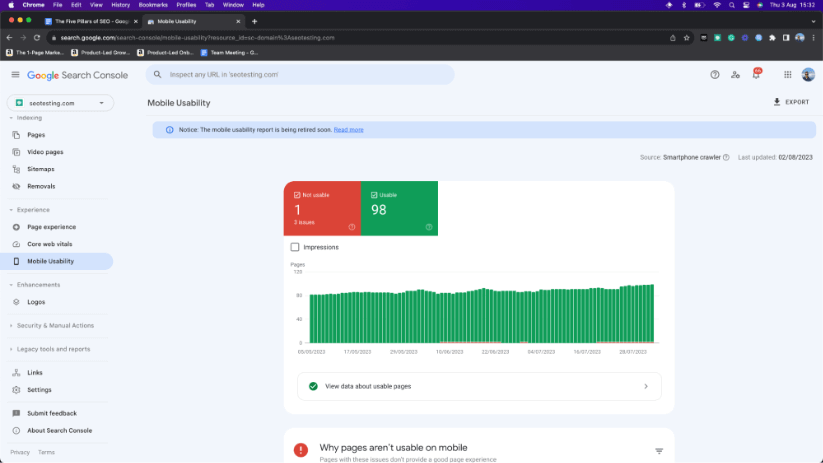
For example, one of our pages had problems.
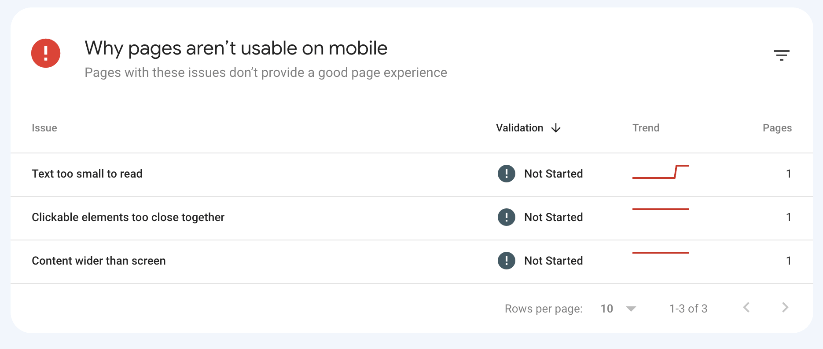
The text was too small to read. Clickable elements were too close together. Some content extended wider than the screen.
We can fix these by:
- Increasing text size
- Spacing elements
- Adjusting content width
These changes ensure better usability on mobile devices.
The Google Search Console report is helpful for all sites. It identifies pages with problems and explains how to fix them. This makes it easier to improve mobile usability.
Pillar 1 – Customer (& Keyword) Research
There are two crucial things you need to ensure your research is complete. This remains the same for any SEO project you are working on. You need to ensure you have researched your customers, and all the keywords they use.
Find your Customers & Their Needs
Finding your customers and their needs is important. There are many ways to do this.
You can use communities like Reddit and Quora. These sites are helpful for finding customers. They have millions of topics. You can search for topics related to your business. Start posting there and researching your customers’ needs. Look for trending topics in your industry.
For example, SEOTesting is a marketing company. We search Quora and Reddit for topics like:
- Marketing
- Digital marketing
- SEO
- Keyword research
These sites always have topics like these. After finding these communities, we look at the questions our audience asks. We plan content to answer those questions. This shows how our product or service can help.
Sparktoro is another useful tool. It helps you find your customers. It shows what they talk about. It also shows where to reach them.
For example, we know our audience talks about SEO testing. We enter this term into Sparktoro. Then we can see what our audience looks like. We see their job titles. We see the hashtags they use. We also see the phrases they use.
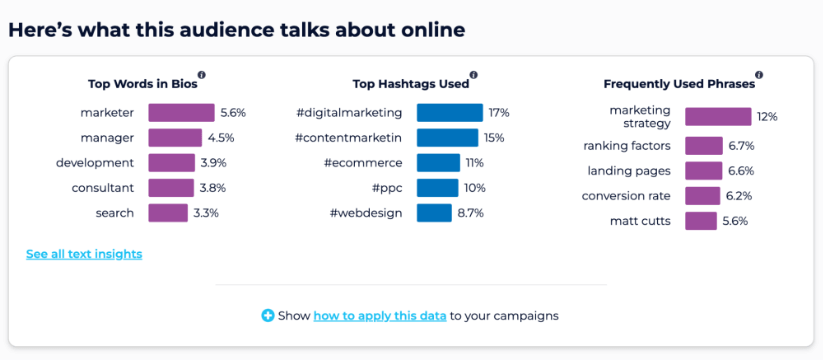
We can also see what social accounts they follow. And what websites they often visit. This gives us some hidden gems for each category:
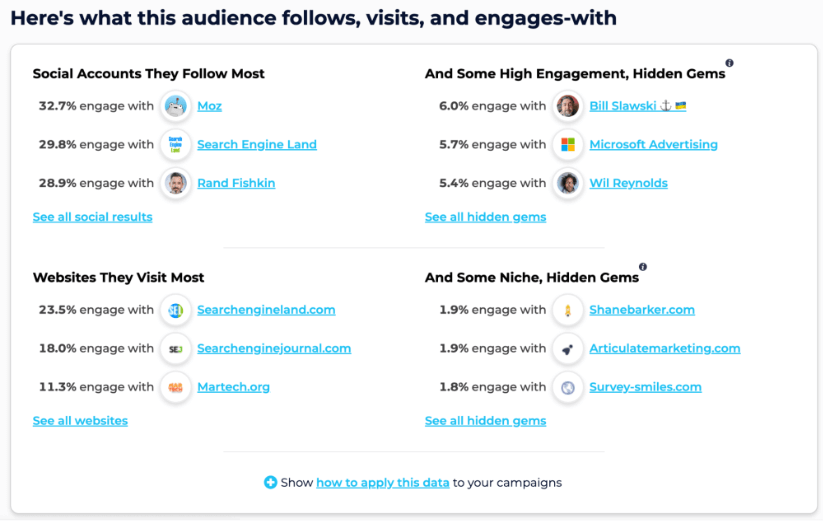
Finally, we can see what our audience watches, listens to, and read:
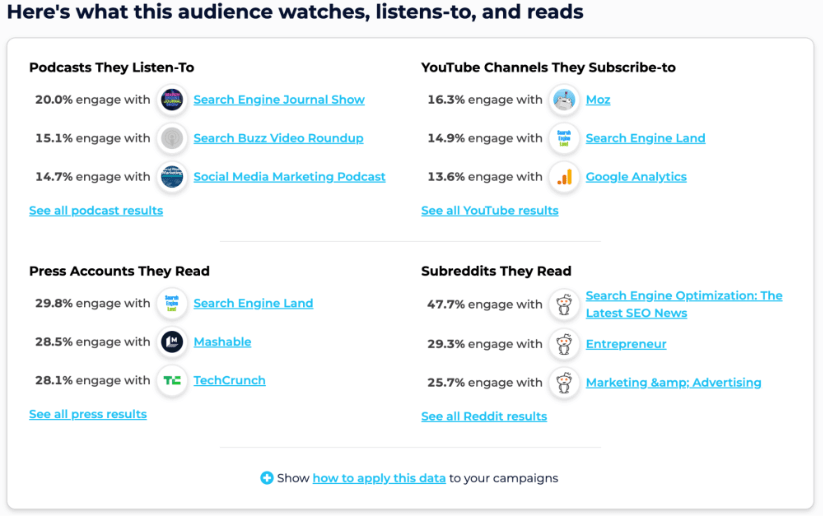
This information is very helpful. We now know which subreddits to join. We have ideas about which press accounts to target for features. We know which podcasts to appear on. We also know the hashtags our audience uses on social media.
This helps us understand our audience better. It also allows us to share our content and solutions with them.
Find your Queries
Finding the queries people use to find businesses like yours is important. It is a key step in a successful SEO campaign. Several tools can make this process easier.
Google Keyword Planner and Google Autocomplete are useful tools. Start with a seed keyword, like SEO testing. These tools show related topics people search for. For example, if we search for “SEO testing,” we see related searches:
- A Chrome extension for SEO testing
- SEO testing tools
- Free SEO testing tools
- Examples of SEO testing
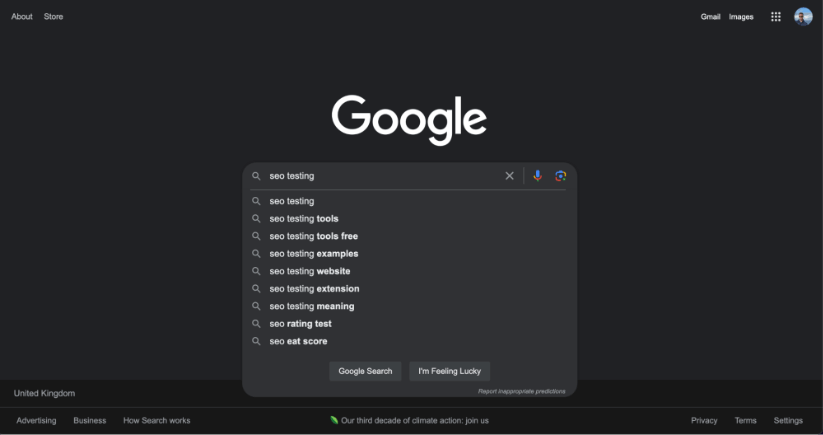
We can create content for these keywords to reach more of our audience.
AlsoAsked is another helpful tool. Start with a seed keyword. It pulls questions from Google’s People Also Ask section. It organizes them into a clear graphic.

These tools show us what people are asking. They help us know which questions to answer.
Check out our guide to find the best free keyword research tools.
Examine the Intent of Your Queries
Different queries have different search intents. Some people search for products to buy. Others search for answers to questions. Keyword intent falls into four categories:
- Informational
- Commercial
- Transactional
- Navigational
Informational searches answer questions. For example, someone might ask which teams Tom Brady played for in the NFL.
Commercial searches help people research before buying. Examples include “best road running shoes” or “best mountain bikes.”
Transactional searches happen when someone wants to buy something. For example, a person might search “red Nike Air Force 1 shoes for sale.”
Navigational searches help users find specific websites. For example, they might search “seotesting.com” or “nfl.com.”
Understanding search intent is important. Content for transactional searches does not work for commercial or informational searches. Match your content to the intent of the search. This is basic SEO.
Pillar 2 – Content Creation & Distribution
Most SEO campaigns succeed or fail during content creation and distribution.
You need great content to rank, especially for high-traffic keywords. But creating content is not enough. If you do not distribute it well, you will struggle to get links and social shares. This will make it harder to improve your ranking.
Content Planning
To create great content, you need good planning. Understand the content you are competing with. Look at the topics they cover and the perspectives they include.
This applies to blogs, podcasts, and YouTube videos. Your content must be better than the competition. This is especially important for high-value, high-conversion keywords.
For extra help, use tools like Keyword Insights to plan content clusters. These tools let you upload a list of keywords. They group the keywords automatically. This shows which keywords need separate content. And which can group together in one piece.
Content Writing
Content writing is one of the most important stages of an SEO campaign. Proper research is also key. Without great content, your work will struggle to rank for your target keywords.
After completing your research, write content that is clear and easy to read. Make sure it covers all the topics from your research. Avoid spelling and grammar mistakes. Match the content length to what competitors are writing. If top-ranking content is over 5,000 words, a 1,000-word blog may not compete well.
Several tools can help with this process. Use online word counters to check content length. Many of these tools also give readability scores. Grammarly helps remove spelling and grammar errors. If you have websites in many languages, translation tools can help. This ensures your content reaches more of your target audience.
Other Content Formats
A successful SEO campaign includes more than written content. You should also use videos and other mediums like podcasts to boost your brand.
For example, creating a YouTube video to support blog posts works on many levels. It can improve on-site metrics like time on page and bounce rate. Videos also help people understand your content better.
Videos can work outside your website too. Uploading them to YouTube lets you reach a new audience. These viewers may subscribe to your channel and watch more of your content.
As marketing shifts toward “zero-click marketing,” owning your audience becomes important. Email newsletters and podcasts can help with this. They can support your written content while also building value for your audience.
Email subscribers can become loyal fans. Podcast listeners can do the same. Owning your audience helps you succeed even as search engines change.
Cross-Channel Distribution
Following on from creating multiple content types, you also need to ensure you are distributing your Creating different types of content is important, but so is distributing it well. Sharing your content across multiple channels gives it a better chance to succeed.
Many companies share blog posts on social media, build a few links, and then stop. But there are many other ways to distribute content.
Next time you publish a blog post, try these ideas:
- Share it on your company’s social media.
- Share it through employees with personal brands.
- Send it to prominent people in your industry.
- Post a summary in relevant Reddit communities.
- Sponsor newsletters and ask them to share it.
Tim Stoddart suggests turning one blog post into 22 pieces of content:
- Write the blog post.
- Create three LinkedIn posts from it.
- Make eight tweets based on it.
- Turn the tweets into short-form videos for TikTok or Instagram Shorts.
- Create a YouTube video about it.
- Send a summary to your email list.
With this approach, one blog post becomes 22 pieces of content to share!
Pillar 3 – Link Acquisition
Links are still the backbone of the internet. They remain one of the most important ranking factors for most websites.
You can succeed in SEO without focusing much on links. But, this success will be limited compared to having a strong link-building strategy.
Link-building methods have changed over the years. What worked in 2010 often no longer works in 2023.
Here are three key tips to remember when building links for your business.
No Cold Outreach
This approach worked well between 2010 and 2015. It can still work today if done correctly. But, I do not recommend cold outreach for link building.
Link building today should focus on two things: authority and relevance. Build links from relevant and authoritative websites. Google often ignores links that are not relevant.
To succeed, build relationships with journalists, business owners, freelance writers, and webmasters. These relationships take time but are key for long-term link building.
This might seem basic, but it is still important in 2023. Do not buy links. It violates Google’s guidelines and can lead to manual penalties against your site.
Press Requests & Thought Leadership
One of the best ways to get links is by using press request services like:
- Help a B2B Writer
- SourceBottle
- Response Source
Some, like Help a B2B Writer and SourceBottle, are free. Others, like Response Source, require payment.
These tools send requests from writers and journalists. They look for comments on topics in your niche. For example, a marketing agency might get alerts for marketing-related content. You can respond to these requests with your expert opinion. If selected, your response may get published.
This helps you get featured on authoritative and relevant websites. It also builds your brand, which we will discuss later.
As your brand grows, more people will seek your advice. You can then use your blog, social media, or email newsletters to share content. This increases the chance of earning links. Because your brand becomes trusted in your industry.
Pillar 4 – User Engagement & Experience
Ensuring your website gives users a great experience is key. Especially since the experience users are having your website correlates to their engagement.
On-Site Metrics
Various on-site metrics help you understand how well your website is performing. In GA4, you can track metrics like:
- Page view
- Scroll
- Session start
- Form start
- Form submit
- Click
These metrics show which pages on your site work well and which do not. If your lead magnet page (like an ebook) gets many form starts but few completions, this signals an issue to fix.
These insights help you convert organic traffic. They guide visitors further through the funnel. Over time, they can turn top-of-the-funnel visitors into brand advocates.
Conversion Rate
Your conversion rate is one of the most important metrics for your website. You could rank first for millions of keywords and bring in huge traffic. But if your website does not convert, your SEO efforts are wasted. Your site will not make money.
You can track your conversion rate using tools like Google Analytics, including GA4. These tools let you define what a conversion means for your business. It could be a product sale or a form submission. They calculate your conversion rate based on goal completions. And the number of visitors.
GA4 also helps you break conversion rates into traffic segments. You might find that direct traffic converts better than organic traffic. Or social traffic may convert less than email traffic. This helps you see which areas need the most attention.
Pillar 5 – Brand Awareness
Brand awareness is an important part of any SEO strategy. Most SEO work focuses on non-branded traffic, but it also helps build brand awareness.
For example, if your website is new and gets 200 clicks a month, your brand awareness will be low. By creating great content and ranking for popular keywords, you can increase traffic. As more people see your content, your brand awareness will grow.
Branded traffic usually converts better. People who know your brand trust you more. They are more likely to buy from you than from a site they do not know.
Building strong brand awareness is key to success.
For more tips, check out this article from Search Engine Journal.
Roof – Testing & Reporting
Now that your SEO foundations and pillars are ready, it’s time to focus on testing and reporting.
Testing and reporting may not seem directly tied to your SEO strategy, but they are important. Doing them well brings many benefits. These include a better chance of getting support and budget for future projects.
Testing
SEO testing is important for most businesses. If you have a website, you can get the benefits of SEO testing.
We know the basics for growing organic traffic. Create useful content for your users. Build relevant, authoritative backlinks. Ensure your website is technically sound.
But what happens after you’ve done all this? Aside from creating more content or getting more backlinks, what else can you do? This is where SEO testing helps.
With SEO testing, you can try changes to your:
- Content
- Meta information
- Backlinks
- Structured data
To boost traffic. You test, learn, and try again.
Past tests show that embedding videos in content increases impressions and clicks. Here’s what happened when we added a YouTube video to an article about robots.txt files:
- Clicks per day increased by 106%.
- Impressions per day increased by 21%.
- The article’s position improved.
- The CTR improved.
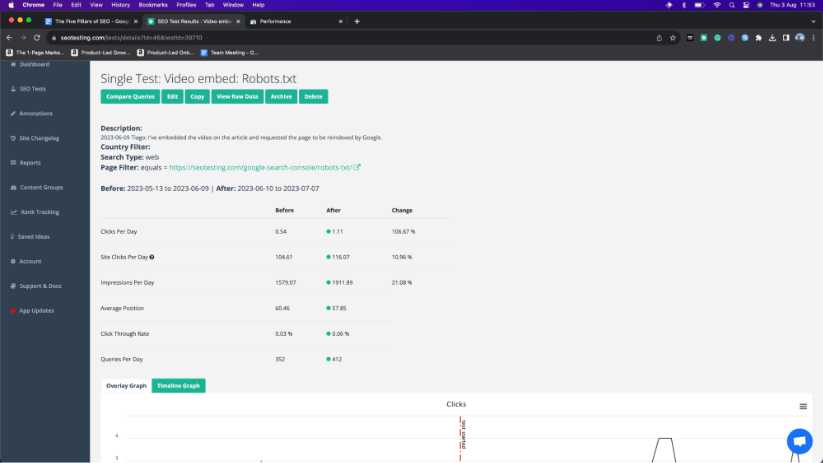
Now, we often create YouTube videos and embed them in our articles. This is one way SEO testing can improve performance.
Reporting
Clear reporting is important for SEO success. You need to share results in a way that stakeholders and managers can understand. This applies to overall organic performance, parts of your site, or tests you have run.
Google Analytics and Google Search Console are helpful tools for reporting. They show data in dashboards that are easy to read. But these tools can be tricky. Getting the right data often takes time and skill. You also need to present the data outside the tools.
Other tools like SEOTesting and AgencyAnalytics make reporting easier. AgencyAnalytics shows your website’s performance at a glance. SEOTesting provides ready-made reports with one click. For example, the “Brand vs Non-Brand” report shows how you perform in brand and non-brand searches. These tools save time and simplify reporting.
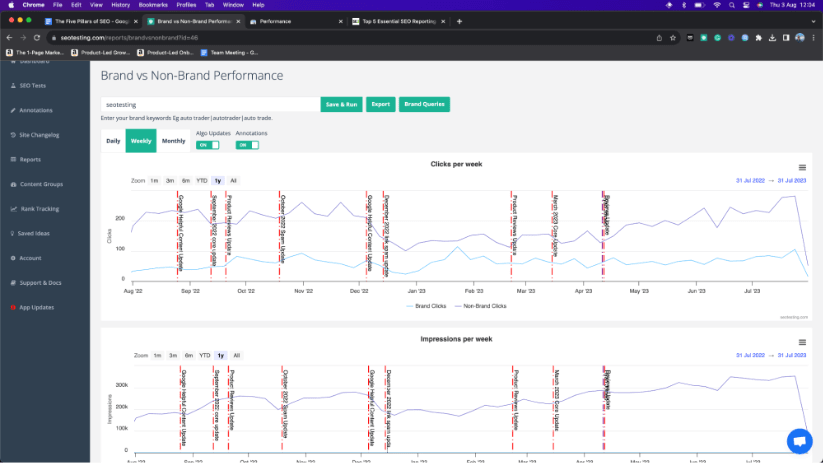
Continuous Improvement & Optimisation
SEO reporting and testing can help you grow organic traffic in surprising ways.
Take the example of adding YouTube videos to blog content. Some businesses write the content, build backlinks, and wait for traffic to grow. This works, but adding a YouTube video can make a big difference. It can help the content perform much better.
At SEOTesting, we focus on improving and optimizing. In just three years, we grew our site from 0 to over 14,000 organic clicks per month by doing this.

Wrapping things up
SEO may seem complex, but success comes from mastering the basics. By focusing on the five pillars:
- Customer and keyword research
- Content creation and distribution
- Link acquisition
- User engagement and experience
- Brand awareness
You can build a strong foundation.
Testing and reporting complete the strategy. They help you refine your efforts and uncover new ways to grow. Small changes, like embedding videos or improving site structure, can lead to significant results.
With consistent improvement and optimization, your organic traffic and conversions will grow. Use these pillars as your guide to long-term SEO success.
Are you looking to make more use of the data within your Google Search Console account? Consider giving SEOTesting a try! We’re not just an SEO testing tool, we have a large range of useful reports, all created to help you better prove your value as an SEO. We are currently running a free, 14-day, free trial with no credit card required to sign-up.

